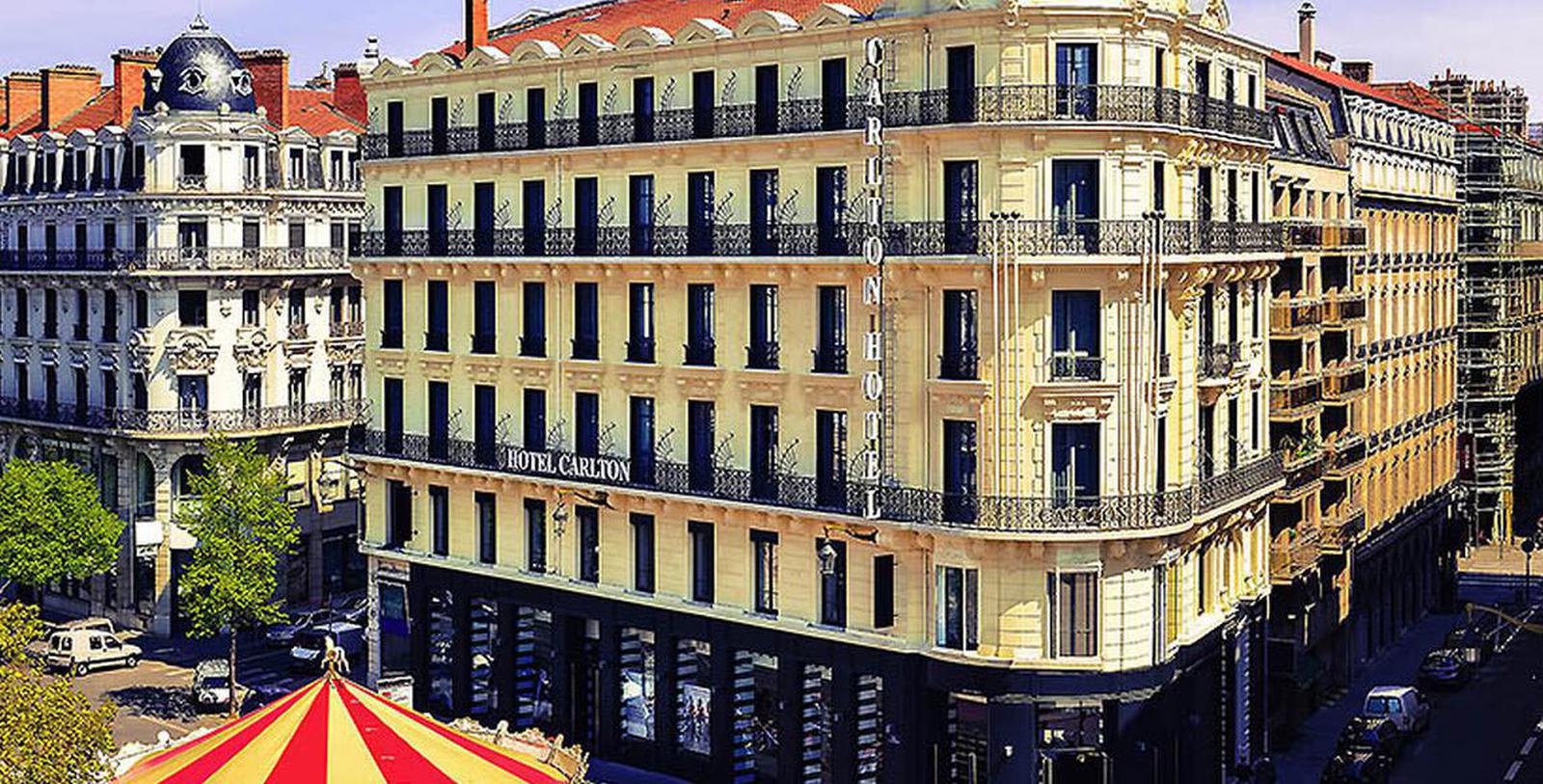Receive for Free - Discover & Explore eNewsletter monthly with advance notice of special offers, packages, and insider savings from 10% - 30% off Best Available Rates at selected hotels.
history
Discover the Hôtel Carlton Lyon - MGallery by Sofitel, which features a historically iconic Roux-Combaluzier elevator.
Hôtel Carlton Lyon - MGallery by Sofitel, a member of Historic Hotels Worldwide since 2018, dates back to 1894.
VIEW TIMELINEA member of Historic Hotels Worldwide since 2018, the Hôtel Carlton Lyon - MGallery by Sofitel is one of Lyon’s most outstanding holiday destinations. Today, its name is synonymous with the ideal of luxury, as the business offers only the finest in modern French comfort and hospitality. But while the building itself originates to 1894, it did not become a hotel until 1925. The building stands today as a magnificent memorial to Georges-Eugène Haussmann’s ambitious plan to rehabilitate France’s intercity neighborhoods during the late 19th century. Its cut-stone, Neo-Classical façade defined Haussmann’s unique architectural style. Shortly after the building became a superb hotel, however, it underwent an extensive overhaul that transformed it into one of the preeminent businesses in all of Lyon. Enterprising hoteliers installed several stunning additions to the building, including a majestic staircase and a set of beautiful stained-glass windows. They even constructed a luxurious Roux-Combaluzier elevator, which has since emerged as one of the hotel’s most iconic features. By the early 2000s, time had clearly taken its toll on the hotel. But Sofitel would ultimately save the structure, initiating its own major renovation in 2013. The project was massive, seeking to preserve its distinct historical charm for future generations to appreciate. Over the course of ten months, Sofitel completely restored the building’s interior, refurbishing its fabulous blue marble floors and pristine woodwork. Fantastic classical décor and sumptuous wallpaper now proliferate throughout the space, paying tribute to the hotel’s founding amid the Roaring Twenties. When construction on the beautiful stone structure finally concluded, it reopened its doors as the luxurious “Hôtel Carlton Lyon - MGallery by Sofitel.” Sofitel is now honored to safeguard the Hôtel Carlton Lyon’s storied legacy as it begins its second century of operation.
-
About the Location +
Lyon is among the most historic communities in France, as its history harkens all the way back to the time of the Romans. In the first century B.C., the Romans constructed the settlement as an outpost at the confluence of the Saône and Rhône rivers. They had specifically intended for the new town to provide a refuge for settlers who had been displaced by a series of destructive wars fought against Central Europe’s Gallic tribes. Selecting a spot atop a hill within Lyon’s modern neighborhood of Fourvière, Roman engineers began establishing a rudimentary grid of interlocking streets and districts. At first, the Roman inhabitants referred to the area as “Colonia Copia Felix Munatia,” before gradually settling on the simpler name of “Lugdunum.” (The town’s original name was a means of invoking the blessings of the gods.) But in a matter of years, the Romans realized the settlement’s strategic importance, especially in relation to its continued conquests across the continent. Its proximity to both the Saône and Rhône made it a central hub for communication across the Roman frontier, too, which attracted all kinds of merchants who were interested in forging trade routes from the Italian Peninsula. As such, a variety of major transcontinental thoroughfares appeared in Lugdunum, further reinforcing its economic and political importance. Soon enough, the town had grown to the size of a sprawling city. Two Roman emperors would even be born in Lugdunum—Claudius and Caracalla.The community also became the capital for the provincial province of Gallia Lugdunensis and its successor state, the Kingdom of the Burgundians, which the Romans created in the 5th century AD.
Lugdunum eventually fell subject the authority of the Holy Roman Empire in 843, although it still remained part of the lesser Kingdom of the Burgundians until the early 10th century. Over time, the realm fractured into smaller fiefdoms, with the city joining the Duchy of Burgundy at the height of the Middle Ages. Nevertheless, the local archbishops wielded the most significant political power at the time, using their influence to hold massive church gatherings within the city limits. A number of the city’s most renowned historic landmarks started to debut, as well, including the Basilica of Saint-Martin d'Ainay, the Église Saint-Paul, and most notably, the Cathédrale Saint-Jean-Baptiste de Lyon, or “Lyon Cathedral.” But at the start of the 1300s, the French king, Philip IV, annexed the entire area, which by that point had become known as just “Lyon.” Under French rule, Lyon experienced a period of prolonged prosperity that culminated with the European Renaissance of the 15th and 16th centuries. Italian traders began holding commercial fairs in the heart of the city, giving rise to a strong financial sector that made Lyon the “counting house” for all of France. Yet, silk trading also emerged as a dominant economic force within Lyon, as did the publication of all kinds of literature. In fact, many famous French writers of the age, including Maurice Scève, Antoine Heroet, and Louise Labé, established residencies within the city. This newfound wealth led to new construction, as well, with the most notable taking place in Lyon’s renowned “Vieux Lyon” neighborhood.
Lyon found itself thoroughly in the heart of the French Revolution, when various Revolutionary armies besieged it in the autumn of 1793. Making matters worse for the inhabitants was the collapse of the domestic silk trade. Fortunately, prosperity returned to Lyon in force in the following century, as the Industrial Revolution took hold over the entire community. Silk itself once again emerged as a powerful trade within Lyon, specifically its refinement into fabric. The influx of new wealth in Lyon spurred yet another wave of building projects that transformed the local skyline to resemble its modern appearance. For instance, many brilliant landmarks opened in the center of Lyon, such as the Palais de la Bourse, the Place des Jacobins, and the Basilica of Notre-Dame de Fourvière. Lyon also saw the creation of its famous network of funicular railways, which remains in operation today. The city is now one of the most culturally vibrant places in France. While its current economy is still largely influenced by silk, it is also home to factories that specialize in the manufacture of commercial dyes, electrical machinery, synthetic fibers, and many other products. It is also the site of many fascinating cultural institutions—such as the Musée des Beaux-Arts de Lyon and the Musée des Tissus et des Arts Décoratifs—making it a contemporary bastion for education and the arts. And most of downtown Lyon has even been listed as a rare UNESCO World Heritage Site!
-
About the Architecture +
The Hôtel Carlton Lyon - MGallery by Sofitel features a wonderful blend of Classical Revival-style architecture. Also known as “Neoclassical,” Classic Revival architecture itself is among the most common architectural forms seen throughout the world today. This wonderful architectural style first became popular in Paris, specifically among French architectural students that studied in Rome in the late 18th century. Upon their return, the architects began emulating aspects of earlier Baroque design aesthetics into their designs, before finally settling on Greco-Roman examples. Over time, the embrace of Greco-Roman themes spread across the world, reaching destinations like Germany, Spain, and Great Britain. As with the equally popular Revivalist styles of the same period, Classical Revival architect found an audience for its more formal nature. It specifically relied on stylistic design elements that incorporated such structural components, like the symmetrical placement of doors and windows, as well as a front porch crowned with a classical pediment. Architects would also install a rounded front portico that possessed a balustraded flat roof. Pilasters and other sculptured ornamentations proliferated throughout the façade of the building, too. Perhaps the most striking feature of buildings designed with Classical Revival-style architecture were massive columns that displayed some combination of Corinthian, Doric, or Ionic capitals. With its Greco-Roman temple-like form, Classical Revival-style architecture was considered most appropriate for municipal buildings like courthouses, libraries, and schools. But the form found its way into more commercial uses over time, such as banks, department stores, and of course, hotels. Architects still rely on Classic Revival architecture when designing new buildings or renovating historic ones, making it among the most ubiquitous architectural styles in the world.


























